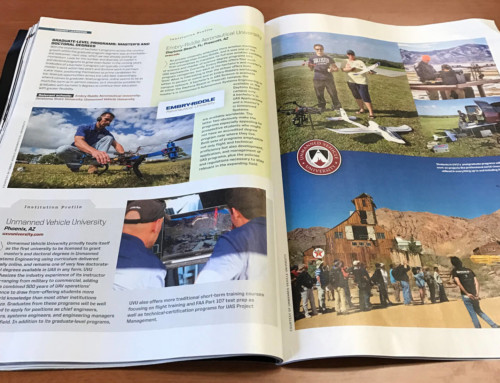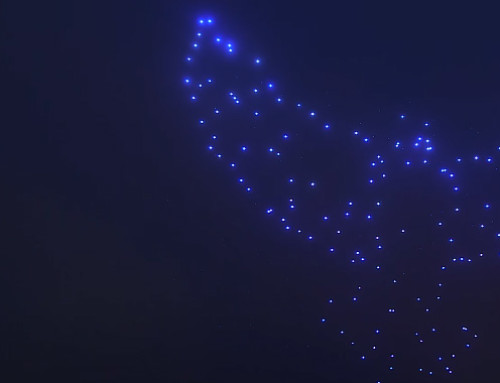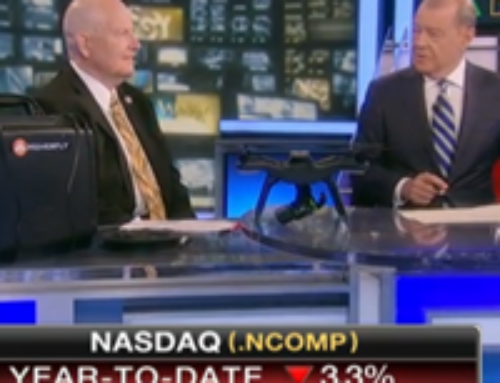he drone university.
In my two previous columns, “The Little Drone Revolution” and “The Drone Association — Know Before You Fly,” I discussed our industry’s opportunity with Unmanned Aerial Systems (UAS), followed by an overview of AUVSI, the Association for Unmanned Vehicle Systems International, an industry focal point for news and regulatory information on unmanned systems.
In this concluding column in the drone series, I’ll explore the educational opportunities for the both the hobbyist and the AV professional who’s interested in honing their UAS skills, and leveraging those skills in the marketplace.
At InfoComm 2015, way down in the Drone Pavilion, I learned about UVU — the Unmanned Vehicle University. I reached out to them after the show, and spoke at length with John Minor, Provost at UVU in Phoenix, Arizona. Now retired from the Air Force, Minor is an expert on airborne remote sensing, with over 25 years of UAV experience in both military and civilian capacities. I asked Minor about the University’s background, and what sets it apart.
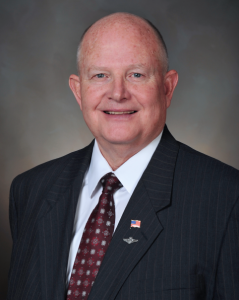
John Minor is the Provost at Unmanned Vehicle University
A Full Spectrum of Education
“The university was formed in 2012 by Jerry Lemieux, a retired Air Force Colonel and Delta Airlines pilot,” explained Minor. “I’ve been with the University from the beginning, initially on a part time basis, because I was working for the Air Force full time. They brought me on board as an instructor, put me on the board of directors, and in January 2015, hired me as the Provost.”
“What’s unique about UVU is that they offer a full spectrum of training and education on unmanned systems. Everybody’s getting into the drone business,” said Minor, “but there’s so many more opportunities these days, not just with flight. You need to design UAVs, build and manufacture them, repair them, and then take them out for specific applications.”
“The applications are tremendous, and we only know what we know today. Ten years from now we’ll be doing things with UAVs that we never thought of today,” Minor continued. “Our school covers the full range of unmanned systems, including aircraft, unmanned ground vehicles like robotic cars, unmanned water vessels both above and below the surface, and we also cover the
unmanned space arena. Of course, the big focus now is on aircraft.”
Advanced Learning
UVU offers on-line graduate programs, and they employ advanced learning management software to deliver the courses. The curriculum includes weekly live lectures, with interactive student/teacher participation. The classes include homework, midterms, final exams, and some courses also include research projects. Classes run the range from systems engineering, to flight test, to conceptual design. And upon graduation, target jobs can carry high salaries — everything from UAV Programmer to Engine Designer to UAV Systems Engineer.
Two degrees are offered: a Master of Science in Unmanned Systems Engineering and a Doctorate of Science in Unmanned Systems, and in each, students can focus on either air, ground, sea or space. Both programs are now going through the accreditation process with the Distance Education Accreditation Council. UVU also offers a special certificate program, where individuals can take four courses, and get a certificate in UAV Project Management.
This area might be of particular interest to our own AV professionals — specifically, someone that might be joining a company that’s creating a new drone department. “We’ve had students take that course, and go right out and start up their own business,” added Minor, “or they’ve headed for companies such as Lockheed or Boeing, and started off with salaries in the six-figure range. How you form a business, what kind of UAVs do you need, and what are the issues with UAVs that need to be solved in order to make a business work — that’s what we teach.”
What It Takes to be Proficient
For the AV professional or videographer that wants to become a pilot and leverage that skill in their own business, UVU offers comprehensive training. “Flight training is done in three sessions,” said Minor. “Most can be done at home, except for the actual hands-on flying aspect. We provide a course of training videos, typically about 16 hours, with rigorous testing in order to demonstrate a high level of proficiency, before students can move on.”
“Once they’ve mastered that knowledge, we send them a simulator for both manned and unmanned aircraft, with at least eight different scenarios,” explained Minor. “Students have to fully master all of those scenarios, and once they achieve that, we schedule their flight training with an instructor. We have expert instructors stationed around the country, in different locations such as Las Vegas, Phoenix, and Sarasota, typically at an Aircraft Model Association field. The instructor takes it from there, with two full days of instruction.”
Minor emphasized that there’s a lot of competition in the training domain, but those typical classes are held for over 100 students with two or three instructors. At the end of the day, a student might have only a few hours of individual training, with the ability to move the drone in all directions — and then they’re signed off.
“We don’t believe in that method,” said Minor. “Most of us are retired Air Force aviators, and we know what it takes to get somebody proficient. We want these guys to be professional, and in the end, if they’re not proficient, we’re not going to give them a certificate. They need to have the aviation knowledge, the airspace knowledge, the safety knowledge, the ethical knowledge, plus the understanding of how drones fly.”
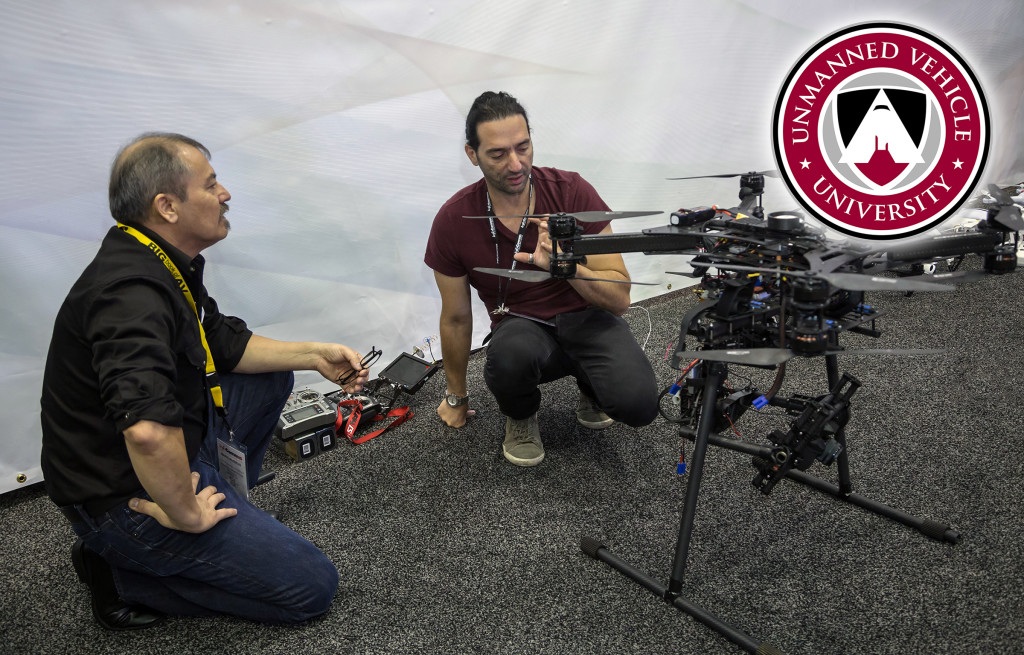
UVU Drone Training at InfoComm
Dragging Their Feet
I asked John about the current challenges he sees in the industry, and the answer was similar to those I’ve spoken to before.
“The number one challenge is getting the FAA to put the actual regulations in place,” said Minor, “because everybody is waiting until the FAA puts pen to paper, stamps it, and says that these are the official rules you’ll go by. In 2012, congress mandated that the FAA was going to integrate drones in national airspace by 2015. Traditionally, they dragged their feet, but In February of this year, they released their proposed set of rules for small unmanned systems. They’ve received a lot of comments, they are adjudicating those comments, and all of us are hopeful that they will produce a set of rules that actually become public law, sometime in early 2016.”
Ethics in the Air
John and I discussed an incident in Southern California, where the airspace over a freeway fire was heavily congested with drones that may, in fact, have prevented some of the first responders from getting into the area. “That’s the exact topic that we teach in the ethics portion of our course,” emphasized Minor. “What is proper, and what is not proper, and a lot of it is common sense, and good aviation sense. In the future, once we have a set of rules, I foresee that there will be battlefield commanders on the ground, and a set of drones will be monitoring the fire. Instead of putting manned aircraft at risk, a set of drones, all interconnected by a data link, can monitor the hot spots and see if any firefighters are in danger of getting closed out. Firefighting applications, law enforcement and public safety applications, I think drones will be big in the future.”
I can clearly see the benefits for commercial and industrial organizations that want to create a UAV department on a professional basis. From law enforcement to agriculture to security, plus the full range of AV applications, the horizons are expanding exponentially, and as Minor emphasized, we only know what we know today.
Minor summed up our discussion in a very concise manner. “If a person wants to be in the UAV business, either working as a systems engineer, a company owner, a business manager or a pilot, the key is proper education and training. Without the education and the training on how to properly use these systems, you are flying blind.”
This article was originally published in PLSN magazine (www.plsn.com), in the January 2016 issue. Paul Berliner is President of Berliner Productions in Davis, California. He can be reached at paul@berlinerproductions.com.


